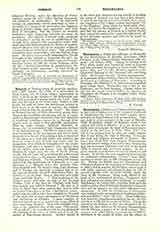

Nemrod, or NIMROD (Hebrew: NMRD of uncertain signification, LXX Greek: Nebrod), the name of a descendant of Chus (Cush), son of Cham (Ham), represented in Gen., x, 8-12, as the founder of the Babylonian empire and as a mighty hunter before the Lord. This last may be taken in the strict sense—hunter of wild beasts, for such we know the Babylonian princes to have been; or in the sense of warrior, the original word gibbor having the meaning “hero”. The name of Nemrod has not yet been discovered among those found in the cuneiform inscriptions, and the attempts made by Assyriologists to identify him with historical or legendary personages known to us through these sources rest on more or less plausible conjectures. Thus by some scholars (Delitsch, Hommel, P. Haupt, etc.) he is identified with Gilgamesh, the hero of the Babylonian epic. The latter, whose name appears frequently in the inscriptions, and who is often represented in the act of strangling a lion, is described in the poem as a powerful prince who subdues the monster ox-faced man Eabani and makes him his companion, after which he triumphs over the tyrant Humbaba, and slays a monster sent against him by the deities, Anu and Ishtar. Like the Biblical Nemrod he reigns over the city of Erech (Douai, Arach), but the texts fail to mention the other towns enumerated in Gen., x, 10, namely: Babylon, Achad, and Chalanne (Calneh). For the philological reasons underlying this hypothesis see Vigouroux, s.v., and Hastings, s.v. Nimrod. Sayce less plausibly identifies Nemrod with the Kassite king, Nazi-Murutas, and T. Pinches (in Hastings) considers him to be the same as Marduk, the great Babylonian deity. In Genesis, x, 11, we read: “Out of that land came forth Assur, and built Ninive … “This rendering of the Vulgate seems preferable to that of the Revised Version: “Out of that land he (Nimrod) went forth into Assyria and builded Nineveh.” Be that as it may, we know from other sources that Assyria with its capital Nineveh was at first a Babylonian colony, and it may be said to have been founded by Nemrod in the sense that it was a development of the power and civilization of Chaldea. A great number of Oriental legends grew up around the meagre Biblical data concerning Nemrod. Thus with probable reference to the supposed root of the name Hebrew: MRD marad, “he revolted”), he is credited with having instigated the building of the tower of Babel and of being the author of Babylonian idolatry. Another legend is to the effect that Abraham having refused to worship the statue of Nemrod was cast into a fiery furnace. A trace of this legend appears in II Esd., ix, 7, where the translator of the Vulgate renders the original “Ur of the Chaldees” (from which the Lord called Abraham), by “fire of the Chaldeans”. It was only natural that the renown of Nemrod as a builder should have caused his name to be connected with nearly all of the principal mounds and ruins to be found in Mesopotamia.
JAMES F. DRISCOLL

